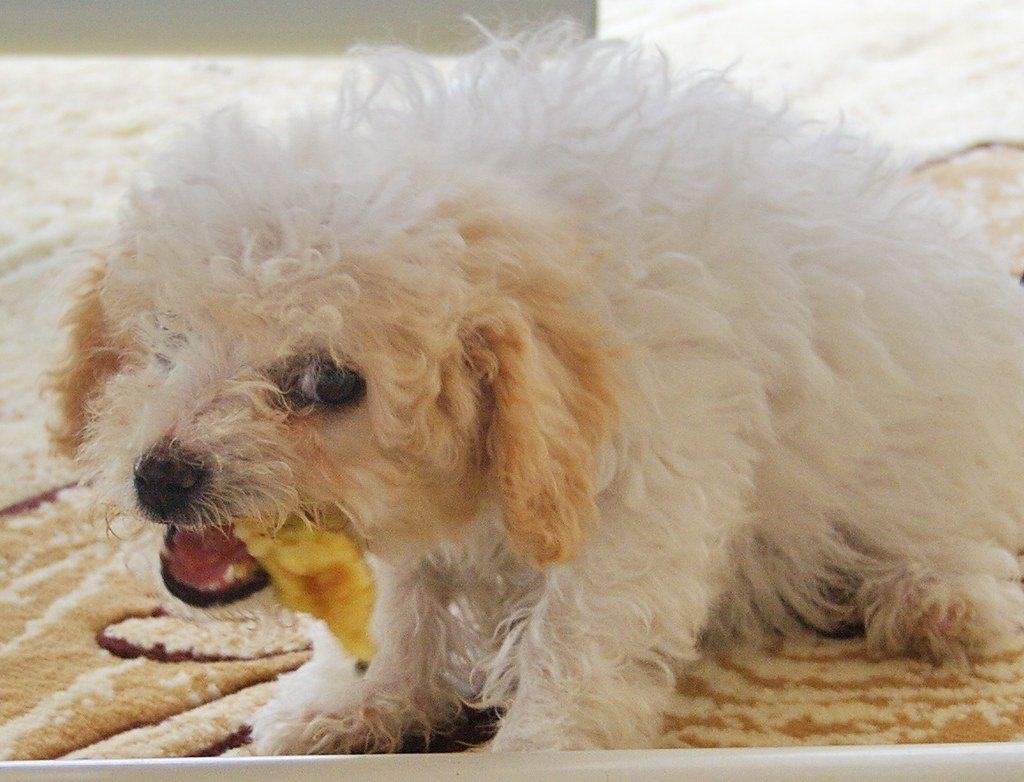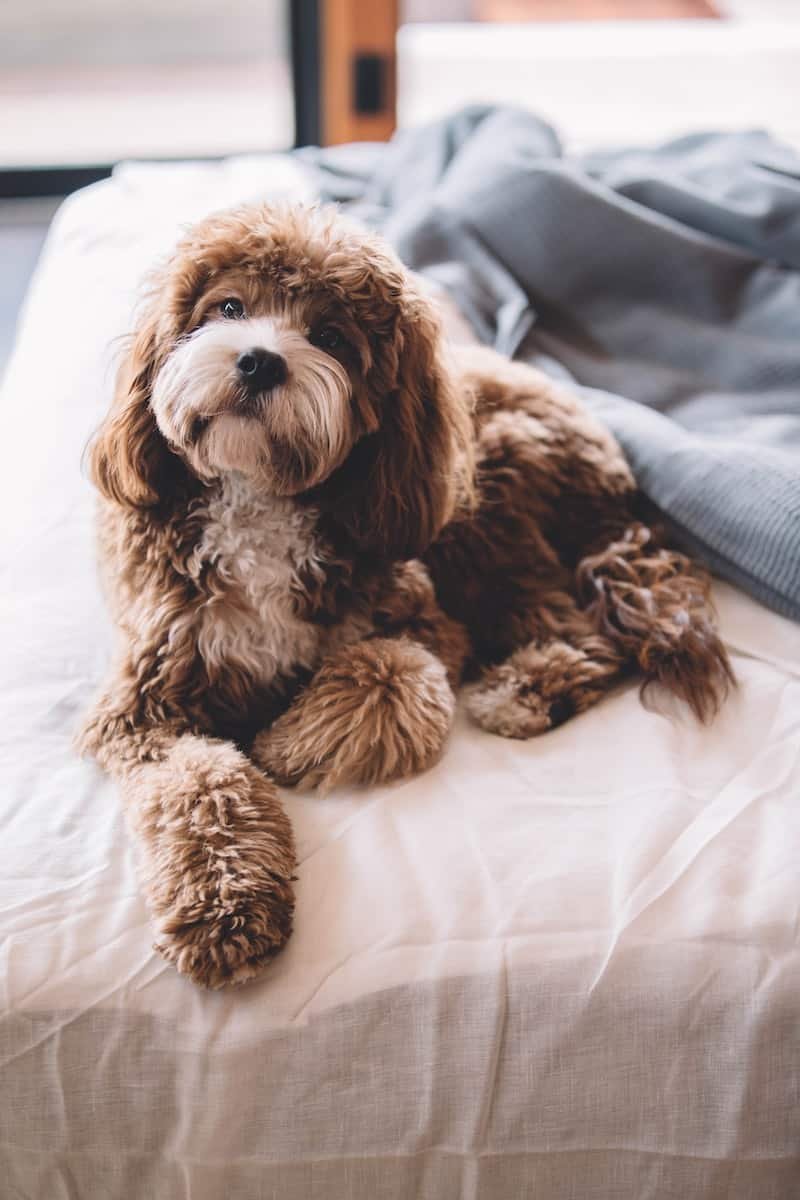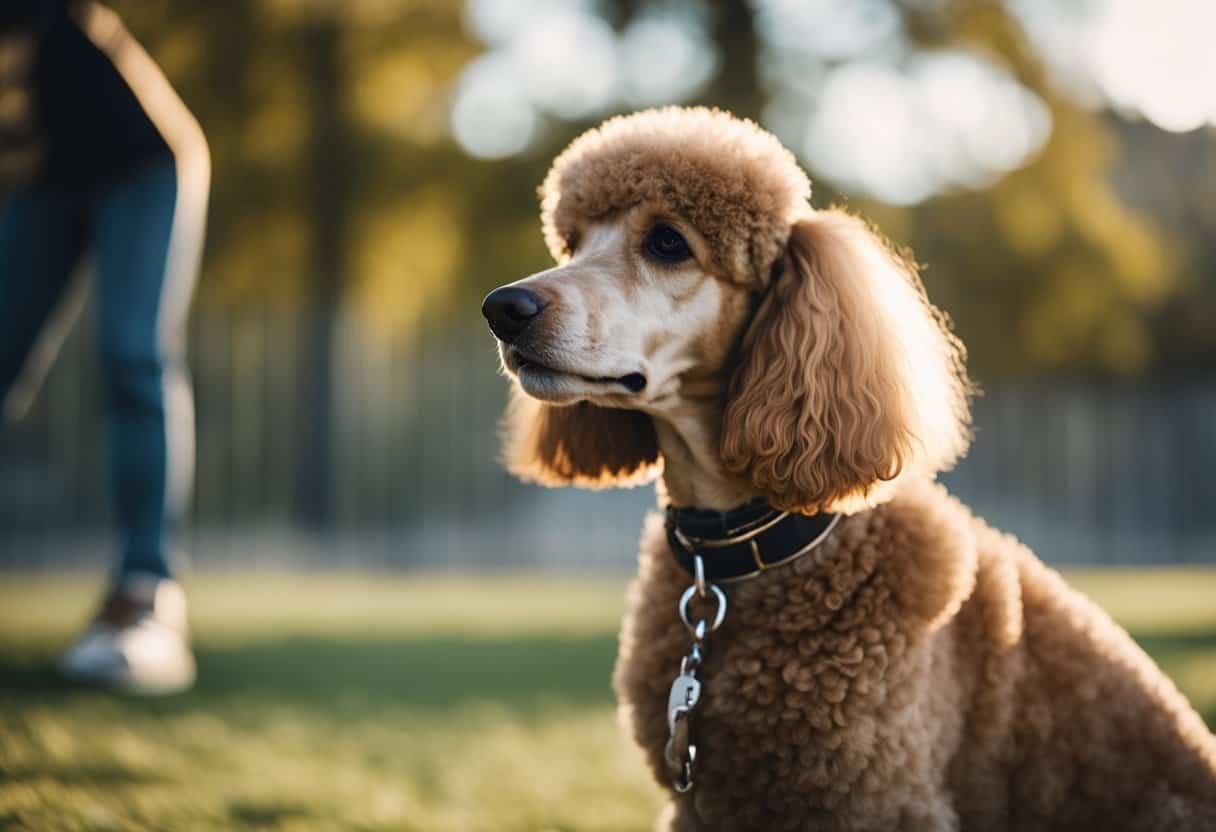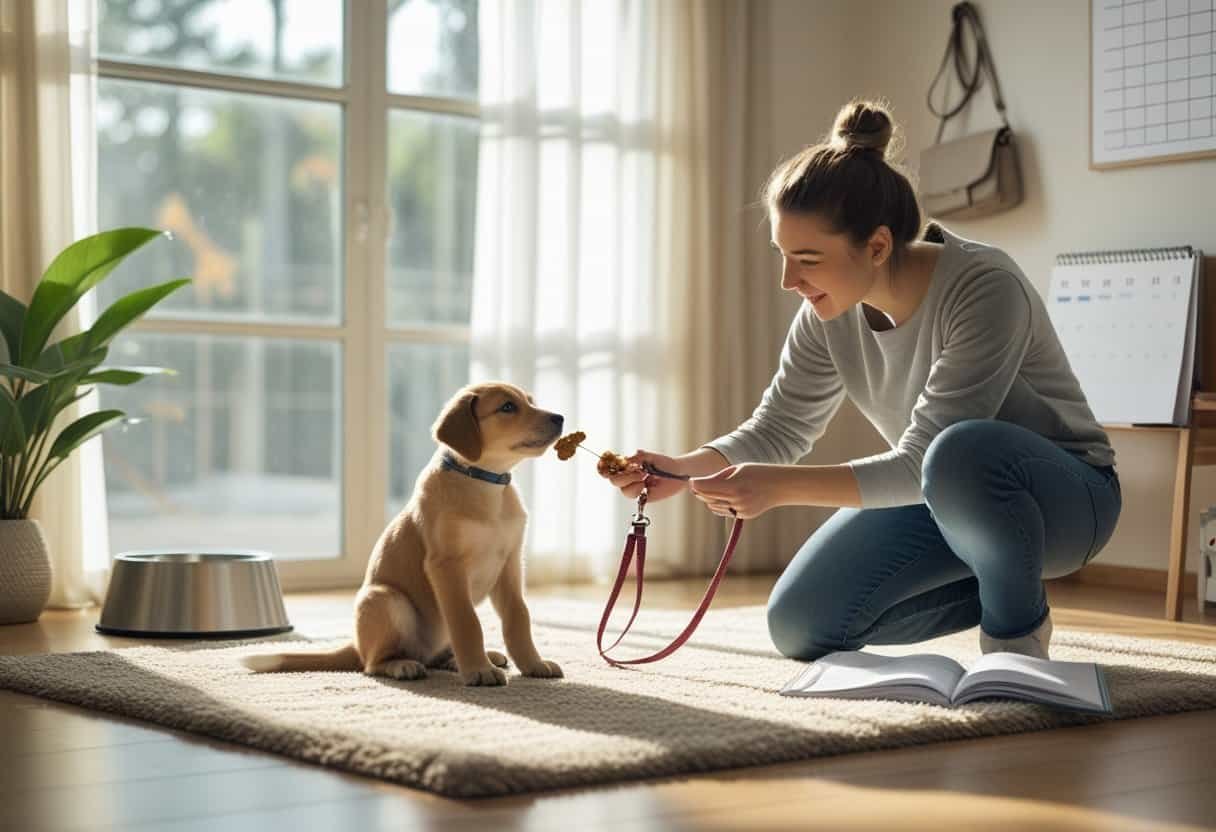
From Our Experience: As poodle enthusiasts who have worked with hundreds of poodle owners and rescue organizations over the years, we’ve gathered real-world insights that go beyond textbook knowledge. The information in this article reflects both professional expertise and hands-on experience with poodles of all sizes and temperaments.
Reasons Why Puppies Bark
Puppies bark for all sorts of reasons. Figuring out the cause goes a long way in calming things down.
Some triggers? They want to interact, need attention, feel alone, or get stressed when you leave.
Communication and Vocalization
Barking is just how puppies talk to us, other animals, and the world. It’s their way of sounding the alarm or saying, “Hey, I’m here!”
You’ll often hear barking when someone comes in the door or if there’s a weird noise outside. Sometimes it’s just excitement during play or a joyful greeting when you walk in.
Puppies use barking to show how they feel. If you listen, you can usually tell the difference between a happy bark and a worried one.
Pay attention to the pitch and rhythm. Excited barks don’t sound like scared or warning barks, right? If you want more detail, check out why barking is a natural form of communication.
Attention-Seeking Barking
Sometimes, puppies bark just to get you to notice them. Maybe they’re bored, hungry, or want to play.
It’s usually a repetitive bark aimed right at you—or sometimes another pet. They might even drag over a toy and bark, practically begging for playtime.
If you always respond, even by scolding, you might accidentally encourage this habit. It’s a bit of a trap.
Try waiting until your puppy is quiet before giving attention or treats. Teaching calmness is a game-changer for noisy pups. Here’s more on how puppies use barking for attention.
Anxiety and Separation Anxiety Barking
Anxiety makes puppies bark, too. New places, loud sounds, or strangers can all set them off.
Separation anxiety is a big one—lots of barking when you leave. You might hear whining or howling soon after you step out.
Some puppies also pace, chew, or scratch at doors when anxious. Creating a safe spot and slowly getting them used to alone time can help.
Music, toys, or treats offer comfort. If your puppy’s anxiety feels overwhelming, a vet or trainer can really help. Learn more about anxiety and separation anxiety barking.
Boredom and Loneliness
Bored puppies bark. If they don’t get enough play or mental challenges, they’ll find ways to fill the silence.
You’ll notice this barking when they’re left alone too long with nothing to do. Sometimes they bark at people passing by or just at thin air.
Lonely barks can sound pretty mournful or high-pitched. To help cut down on barking from boredom and loneliness:
- Go for daily walks and play sessions
- Swap out toys so things stay fresh
- Try puzzle feeders or little “jobs” that make them think
Don’t leave your puppy alone for ages if you can help it. A tired, busy puppy is way less likely to bark for no reason. For more tips, check out this guide on puppy barking.
Understanding Barking Behavior in Puppies
Puppy barking is totally normal. It’s how young dogs show excitement, ask for attention, or react to new things.
Spotting the difference between typical barking and a problem behavior helps you step in early.
Normal vs. Excessive Barking
All puppies bark—it’s part of growing up. You’ll hear it when they greet you, warn about strangers, or just play.
But when barking gets out of hand, you might have a problem. Some breeds are just louder, but if your puppy barks way more than seems normal, it’s time to pay attention.
Track when and why the barking happens. Triggers like strangers, other animals, or being left alone are common.
If barking feels constant or seems to stress your puppy, it could mean anxiety or a behavior issue. Catch it early to avoid it becoming a habit. Here’s a handy guide to puppy barking behavior.
Demand Barking
Demand barking is when your puppy barks to get what they want—attention, food, or toys. This usually starts if you give in whenever they bark.
You’ll notice this if your puppy barks at mealtime, when you’re holding a toy, or when you stop petting them. Sometimes they even follow you around, barking for play.
Best thing to do? Ignore the barking and only reward quiet moments. If you give in, the barking just gets worse.
Teach a “quiet” command and reward your puppy the second they stop barking. Stay cool and don’t yell—it just makes things louder. Here’s more on puppy barking and how to manage it.
Nighttime Barking
Nighttime barking can drive anyone nuts. Puppies often bark at night because they’re lonely, scared, or need the bathroom.
Young pups aren’t used to sleeping alone or in a new place. To help cut down on nighttime noise:
- Make sure your puppy has a comfy, safe sleeping area
- Try a bedtime routine: last potty break, a bit of gentle play, and some quiet time
- Don’t rush in every time your puppy barks at night
If you hear barking with whining, your puppy might need to go out. Most nighttime barking fades as your pup gets older and settles in.
If it keeps up, try crate training or a white noise machine. More on training a noisy puppy to quiet down.
Assessing the Root Causes of Puppy Barking
Understanding why your puppy barks is step one. Not enough exercise, boredom, or unmet needs like hunger and stress are common culprits.
Lack of Exercise
Puppies have energy to burn. If you skip walks or play, your puppy might bark at everything that moves.
Restless or frustrated puppies often bark at people, animals, or cars outside the window. A regular routine—walks, playtime, and outdoor breaks—helps burn off that extra energy.
Big breeds need longer walks, but even little guys benefit from short, frequent activity. Games like fetch or tug-of-war work wonders.
A tired puppy just doesn’t have the juice to bark out of boredom or frustration. Making sure they get enough exercise is key.
Mental Stimulation and Enrichment
Physical activity isn’t enough. Puppies need mental stimulation to stay happy and quiet.
If your puppy gets bored, barking is just one way they’ll try to get your attention. Enrichment keeps them busy and cuts down on bad habits.
Try these ideas:
- Puzzle toys and treat balls
- Switching up toys so nothing gets old
- Basic training games that teach new skills
Taking your puppy to new places or letting them meet other dogs helps too. Mental stimulation and enrichment make a big difference.
Unmet Physical or Emotional Needs
Sometimes, barking means your puppy needs something—food, water, a bathroom break, or just some company. Stress or anxiety can also be triggers.
Don’t give in to barking every time, but make sure basic needs are covered. A routine helps your puppy know what’s coming next.
If your puppy is scared or anxious, a little extra comfort goes a long way. Solving unmet physical or emotional needs helps puppies feel safe and bark less. It takes patience, training, and a bit of trial and error.
Training Techniques to Reduce Barking
Cutting down on barking takes planning, patience, and a little creativity. The right training makes a world of difference.
Positive Reinforcement Strategies
Positive reinforcement works wonders. Reward your puppy for being quiet—treats, praise, or a quick play session do the trick.
Give the reward right after your puppy stops barking. Timing matters—a lot.
Consistency is huge. Reward every quiet moment, not just sometimes. Eventually, your puppy will figure it out.
If your puppy barks for attention, ignore it until they’re quiet, then reward. Positive reinforcement beats punishment every time. For more ideas, check these vet-approved training strategies.
Consistency and Patience in Training
Training takes time—no way around it. Everyone in your house should use the same commands and rules.
Mixed messages just slow things down. Pick a “quiet” cue and use the same word and tone each time.
Practice a few times a day in short bursts. Some puppies catch on fast, others need more time—don’t sweat it.
Stay calm, even if you’re frustrated. Never yell or punish; it just makes things worse.
Consistency and patience build trust and better results. Experts at the American Kennel Club have more solid advice if you want to dig deeper.
Desensitization Training
Desensitization lets puppies get used to things that make them bark. First, figure out what sets them off—maybe visitors or weird noises outside.
Expose your puppy to the trigger gently, like playing a sound softly or letting them spot a stranger from a distance. Over time, bring the trigger closer or make it a bit louder, but go slow.
If your puppy stays calm, give them a treat or some praise. If they bark, back off and try again later, maybe with less intensity.
Go at your puppy’s pace. Gentle, frequent exposure seems to work best.
You’re aiming to help your puppy stay relaxed in situations that used to make them bark. This simple desensitization process can really help if you stick with it.
Crate Training and Creating a Comfortable Sleeping Environment
A calm, secure crate space can lower a puppy’s barking. Even small changes, like a set bedtime routine or a white noise machine, help puppies feel safer and more ready to sleep.
Bedtime Routine for Puppies
A regular bedtime routine tells your puppy it’s time to wind down. Try a gentle walk, a bathroom break, and a little quiet time together before bed.
Keep lights low and voices soft to help calm things down. Add a comfortable bed or a soft blanket inside the crate.
Puppies will bark if they’re cold or uncomfortable, so check for drafts and make sure the crate feels cozy. Some folks cover the crate with a light blanket for a den-like feeling.
Veterinarians say a den-like environment can help puppies feel more secure and bark less at night. For more on this, here are some tips for a comfortable sleeping area.
Stick to the same bedtime every night. Routines help puppies figure out when to sleep and when it’s playtime.
Using White Noise Machines
White noise machines can help puppies settle in their crates, especially if outside sounds make them bark. These machines play gentle sounds like rain or soft static, which can drown out noises from the house or street.
Set the white noise machine near the crate, not inside. This helps block sudden sounds that might startle your puppy.
Some people use a fan or quiet music for the same effect. If your puppy gets anxious at night, white noise might calm them by making things feel steady and familiar.
It’s a simple step that can really help with crate barking and nighttime rest. White noise works best when you combine it with other calming bedtime habits.
Building a Daily Routine to Prevent Barking

A consistent routine helps puppies feel secure. Regular schedules for meals, play, and sleep really cut down on barking.
Set Feeding and Play Times
Feed your puppy at the same times every day. Predictable meals stop food-related anxiety and random barking for attention.
Playtime is just as important. Scheduled play burns off energy and gives your puppy a healthy outlet.
Games like fetch or tug-of-war tire them out, both mentally and physically. After play, most puppies are ready to chill out.
Structured play also gives you a chance to reward quiet behavior. This way, your puppy learns that calmness leads to good things.
If you’re curious about why puppies bark, check out puppy barking causes and training.
Scheduled Rest and Nap Periods
Young puppies need a lot of sleep—think 16 to 18 hours a day. Without enough rest, they get cranky and bark or whine more.
Set up a quiet, comfy nap spot. A crate or soft bed in a low-traffic area works well.
Stick to regular nap times. Puppies, like kids, thrive on a sleep routine.
Encourage naps after play or meals. If your puppy barks during quiet periods, check if they’re overtired.
Training your puppy to rest at certain times usually leads to better behavior and less noise in the long run. For more tips, here’s some advice on stopping excessive barking.
Encouraging Calm Behavior in Puppies
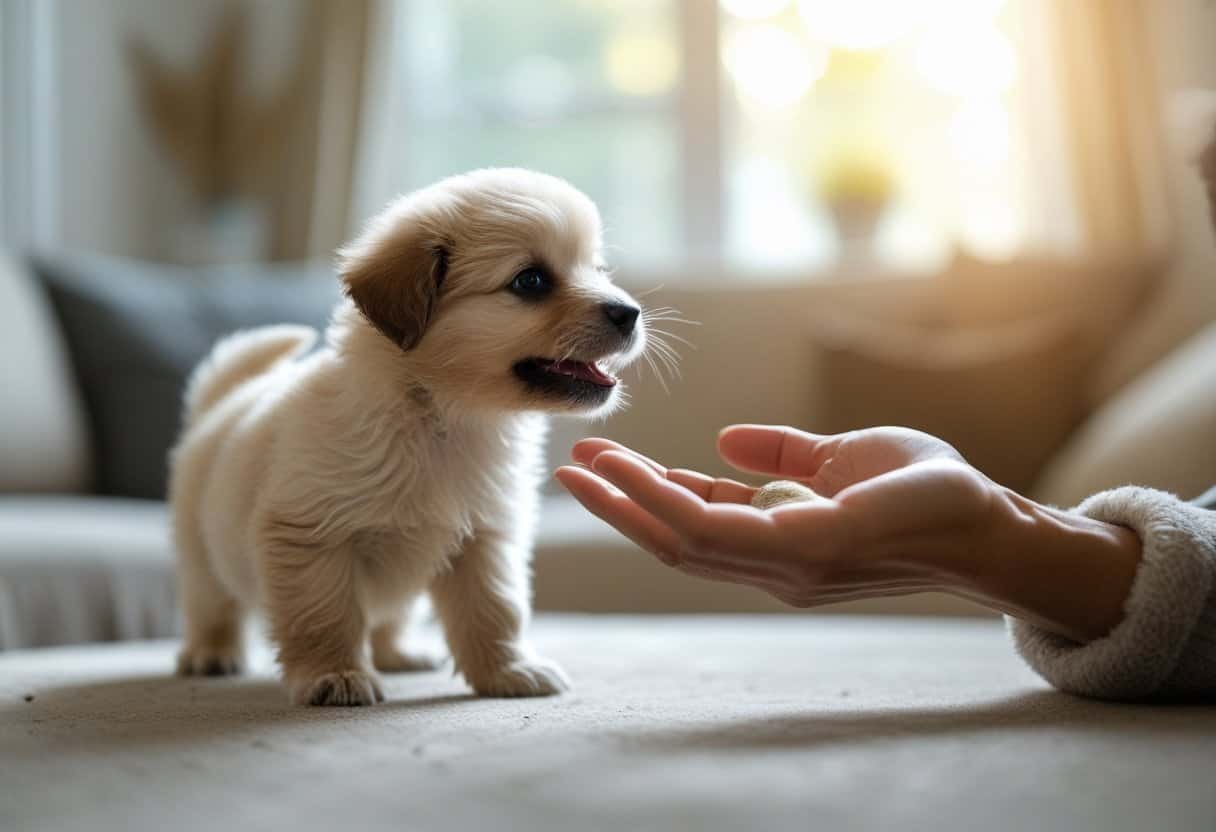
Teaching puppies to be calm starts with keeping them busy, both mentally and physically. Toys and puzzles are great for channeling energy and cutting down on barking.
Redirecting Attention with Chew Toys
Chew toys are a simple fix for puppies who bark out of boredom or frustration. Give them a safe, sturdy chew toy to stop unwanted barking and destructive habits.
Puppies love to chew, especially when teething. Having a chew toy nearby satisfies that urge and gives them a positive distraction.
Pick chew toys that are the right size and tough enough to last. Avoid anything they can break or swallow.
Some chew toys have different textures or flavors to keep things interesting. When your puppy barks, calmly hand them the chew toy.
Praise quiet, calm behavior. Over time, this positive reinforcement helps your puppy learn that being quiet pays off.
If you want more ideas, check out positive reinforcement training techniques.
Providing Interactive Toys and Puzzles
Interactive toys and puzzles keep your puppy’s brain busy. Toys that dispense treats or require problem-solving, like puzzle feeders, give them something to focus on instead of barking.
Regular use of interactive toys helps puppies build patience and problem-solving skills.
Table: Examples of Interactive Toys and Puzzles
| Toy Type | Example Use |
|---|---|
| Puzzle Feeder | Hide kibble for slow eating |
| Treat Ball | Roll to release small treats |
| Tug Toy | Safe game for bonding |
Switch up the toys to keep things fresh. Make sure puzzles match your puppy’s age and skill level.
Interactive toys help create a calmer home by tiring out and entertaining your puppy. If you’re curious, here’s more on mental challenges and barking and puppy barking management.
Socialization Strategies for Young Dogs

Building a confident, less-barky puppy starts with good socialization. Early, positive experiences lay the groundwork for a well-adjusted adult dog.
Introducing New Experiences
Puppies need to see and interact with lots of places, people, animals, and objects. The best window for this is between 8 and 16 weeks old.
Let your puppy visit parks, stroll down busy streets, or meet friendly strangers. Each outing boosts their comfort in new settings.
Keep things positive—offer treats and praise when your puppy acts calm or curious. Invite friends over and let your puppy interact at their own pace.
Don’t force new experiences. If your puppy seems nervous, let them watch from a safe spot until they relax.
Short, upbeat encounters work best. Consistent outings build confidence and help cut down on barking from surprise or stress.
If you want more, here’s some puppy socialization advice.
Preventing Fear-Based Barking
Fear-based barking usually starts when puppies feel overwhelmed or unsafe. You can help by introducing new sounds, sights, and people at your puppy’s pace.
If your puppy barks, stay calm—don’t scold. Negative reactions just make things worse.
Reward quiet moments with gentle petting or treats. Only make things harder when your puppy is calm.
For example, turn on the vacuum in another room first, then bring it closer later. This way, your puppy learns new things aren’t so scary.
Proper socialization lowers the odds of barking from fear or anxiety. Practice makes surprises easier for your puppy to handle.
If you need more info, here are some tips on reducing fear-based barking.
Common Mistakes When Addressing Puppy Barking
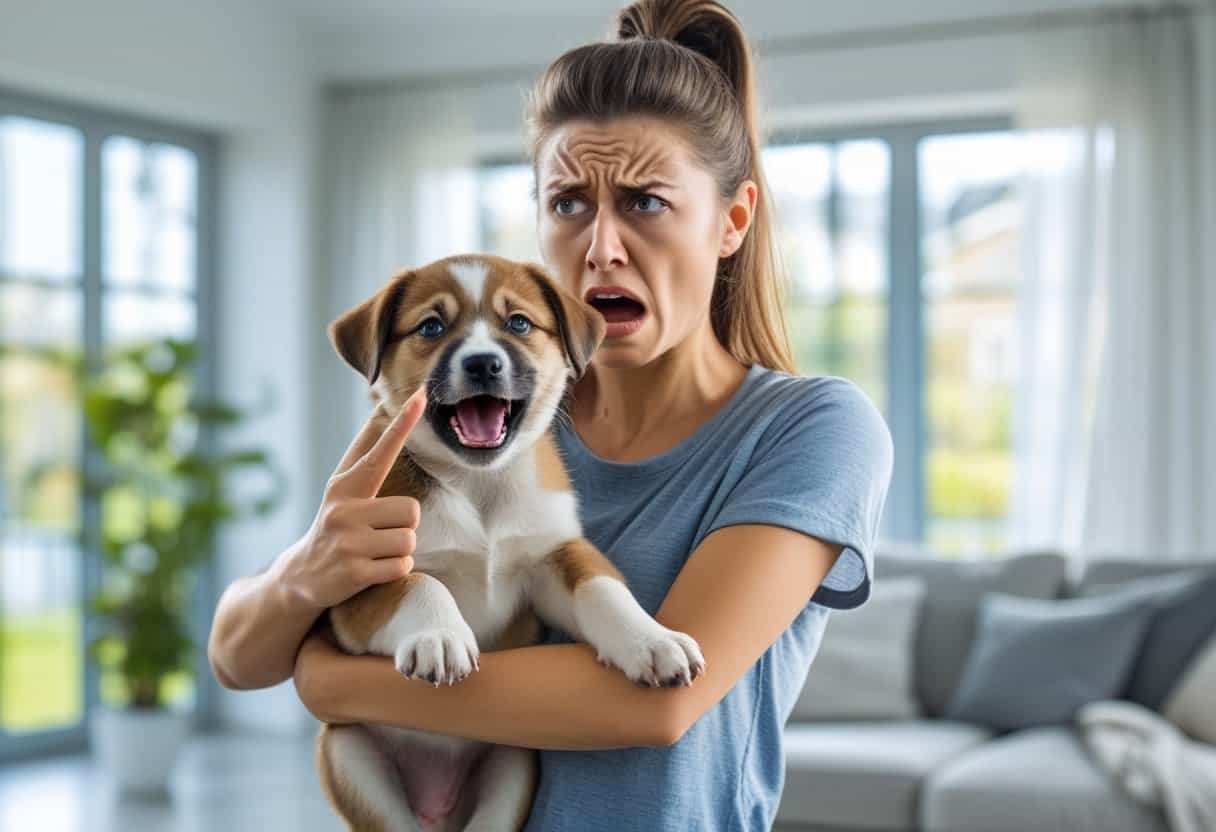
People often make simple mistakes when trying to stop puppy barking. Sometimes these actions just make things worse.
Risks of Punishment
Punishing a barking puppy might seem like a quick fix, but it usually backfires. Yelling, making loud noises, or using physical corrections just makes puppies scared or anxious.
This kind of stress can lead to even more barking or new problems, like hiding or acting out. Punishment doesn’t teach your puppy what to do instead.
Puppies can get confused about what you want from them. Sometimes, it even damages your bond.
Instead, stick with positive training methods. Experts agree that punishment often backfires.
Unintentional Reinforcement
Sometimes, giving your puppy attention when they bark—petting, talking, or even eye contact—just encourages the noise. Puppies learn fast that barking gets a reaction, good or bad.
Common mistakes:
- Giving treats or picking up the puppy while it barks
- Responding to barking by meeting its needs right away, like opening a door
Wait for quiet before offering rewards or attention. Set routines and keep puppies busy with play, walks, and puzzles to help them bark less for attention.
Consistency is key to avoid mixed signals.
When to Seek Professional Help
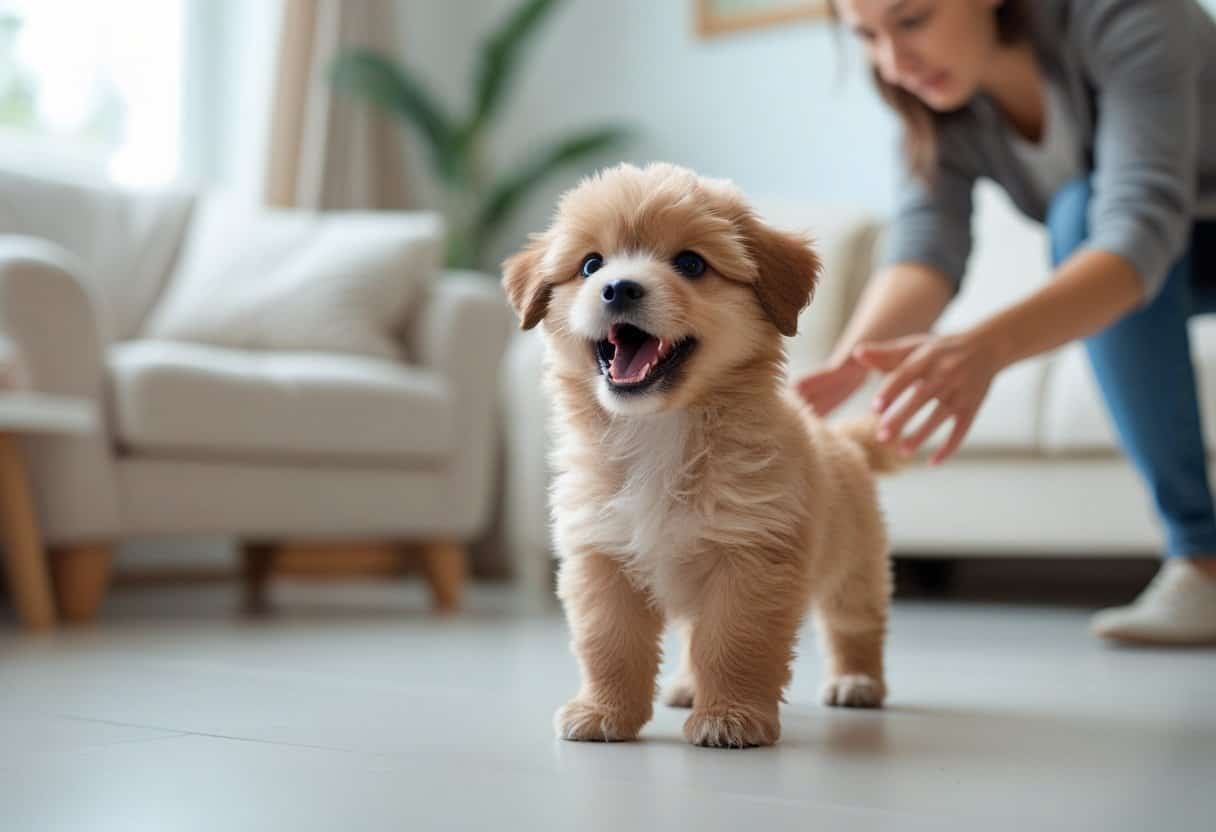
If your puppy’s barking gets out of hand or starts causing chaos at home, you might want to reach out to an expert. Some barking can be handled with home training, but aggressive, nonstop, or super disruptive barking usually calls for a pro.
Consulting a Professional Dog Trainer
A professional dog trainer can jump in, see what’s really happening, and help both you and your puppy tackle problem barking. Trainers have tried-and-true ways to deal with barking at strangers, endless barking at noises, or barking just for attention.
In-person sessions give the trainer a front-row seat to your puppy’s habits, so they can suggest clear, step-by-step changes. Many trainers will build a custom training plan for your puppy and family.
When searching for a trainer, it’s smart to check for good reviews and experience with young dogs. You can find more details about reaching out to a trainer at this page on puppy barking and managing it.
Working with an Animal Behaviorist
If your puppy’s barking seems tied to anxiety, fear, or something deeper, an animal behaviorist might be the way to go. These folks know dog behavior inside and out and can dig into the root causes behind tricky barking.
They’ll use different tests, ask about your puppy’s history, and watch how things play out at home. Then, they’ll work with you to build strategies that target the real problem, not just the noise.
This is especially useful when barking doesn’t budge with regular training or comes with other concerning behavior. Here’s more on when persistent, disruptive barking might need professional guidance.
Long-Term Success and Maintenance
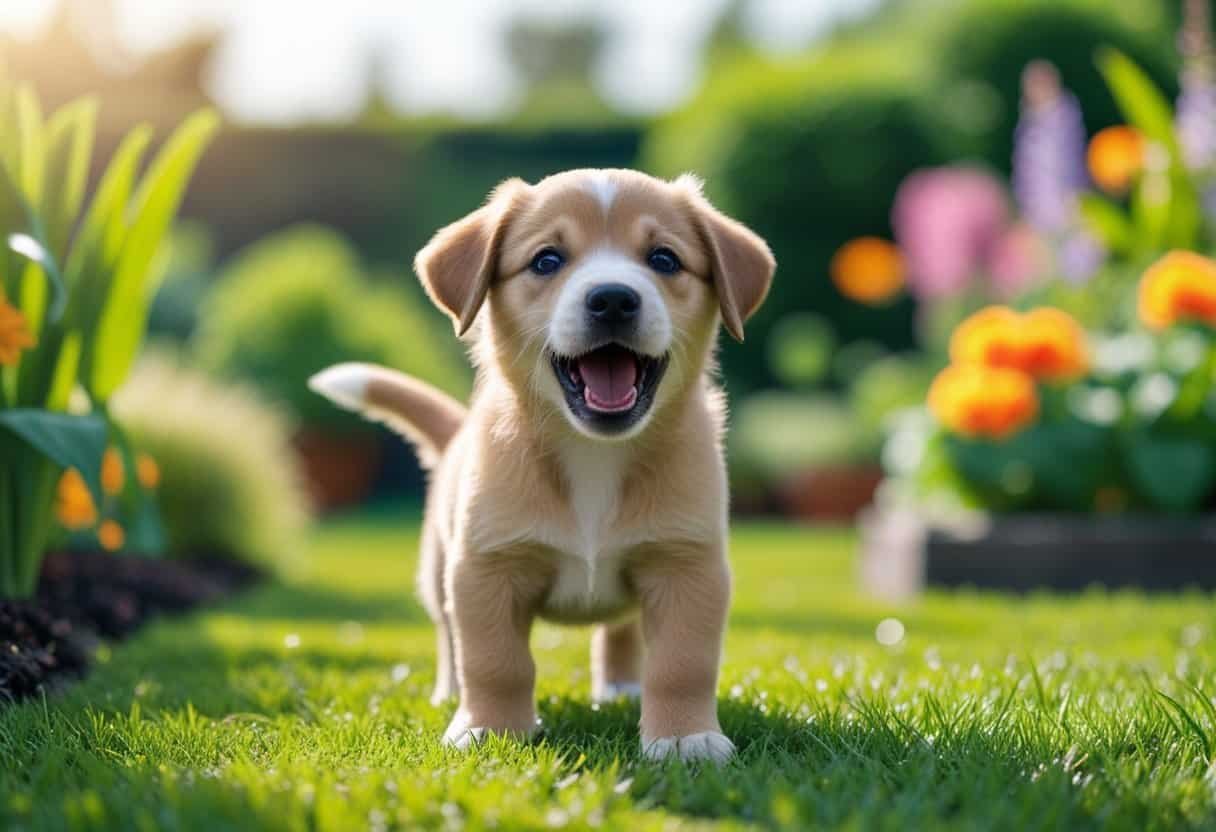
Building lasting good habits around barking takes regular check-ins and a bit of flexibility. You’ll need patience, consistency, and a willingness to notice what’s working—or not.
Monitoring Progress
Try keeping a simple chart or daily log to track your puppy’s barking patterns. Write down when they bark, how long it lasts, and what set it off.
Spotting trends gets easier when you see everything laid out. If barking gets better or worse, you’ll catch it sooner.
Reward even short moments of quiet to reinforce calm behavior. Treats, praise, or a favorite toy every time your puppy stops barking on their own can make a big difference.
Give positive feedback right away so your puppy connects silence with good things. Frequent check-ins help keep those good habits going strong.
If barking creeps back in, double-check your routines and make sure rewards are timely. For more tips, check out this puppy barking management article.
Adapting Strategies as Puppies Grow
A puppy’s needs shift as they grow up. What worked for a tiny pup might not cut it for a teenager.
Watch for new triggers, like unfamiliar people or strange noises, and tweak your approach if barking ramps up again. Older puppies often need more exercise, mental challenges, or social time to keep boredom at bay.
Try adding interactive toys, extra training, or playdates to burn off energy and keep stress low. If your puppy starts barking out of fear, take them out of the scary spot and comfort them—maybe with a gentle pet or a treat, as suggested in this training guide for noisy puppies.
Checking in on your routines and strategies every so often helps you keep pace with your puppy’s changing needs and stay ahead of unwanted barking.
Frequently Asked Questions

Puppies bark for all kinds of reasons—boredom, wanting attention, or just figuring out new situations. With some training, a solid routine, and a bit of insight into their needs, you can usually keep barking in check.
What techniques can be used to quiet a puppy barking for attention?
Teaching your puppy to settle down on command helps a lot. If you ignore barking for attention and only give love when they’re quiet, your puppy learns that silence gets them what they want.
Toys, puzzle feeders, or short play breaks can head off boredom barking. Short, gentle commands like “quiet” can reinforce good moments.
Why might a puppy suddenly start barking excessively at their owner?
Sometimes a puppy barks more at their owner because they’re anxious, restless, or something in the routine has changed. Stress, a new place, or new faces in the house can spark barking.
Other times, they just want attention or feel lonely.
What are effective methods to prevent a puppy from barking when left alone?
Most puppies bark when left alone because they’re nervous about being separated. Give them a cozy, comfortable space, leave something with your scent, and slowly build up their alone time.
Calming music or a white noise machine can also help reduce a puppy’s anxiety.
How can I teach my puppy to stop barking at night?
Nighttime barking usually means your puppy’s scared, needs a bathroom break, or just doesn’t feel settled. Set them up with a soft bed in a quiet spot and stick to a bedtime routine.
If you check on them, keep it calm and brief—don’t turn it into playtime. That way, your puppy learns that nighttime is for resting.
At what age do puppies typically outgrow excessive barking phases?
Most puppies start to move past the worst barking phases between 6 and 12 months old. It varies a bit by breed and personality.
If you stick with training and positive reinforcement, chances are your dog will get quieter as they grow up.
What strategies adhere to the ‘3 bark rule’ for training puppies?
The “3 bark rule” means you wait until your puppy barks three times. After that, you calmly interrupt with a cue like “quiet.”
If your puppy stops barking, give them a reward right away. This way, they start to get when to stop.
It’s a pretty straightforward approach to teach better control over barking.
Ready to Adopt a Poodle?
Find poodles waiting for their forever home in your area.


